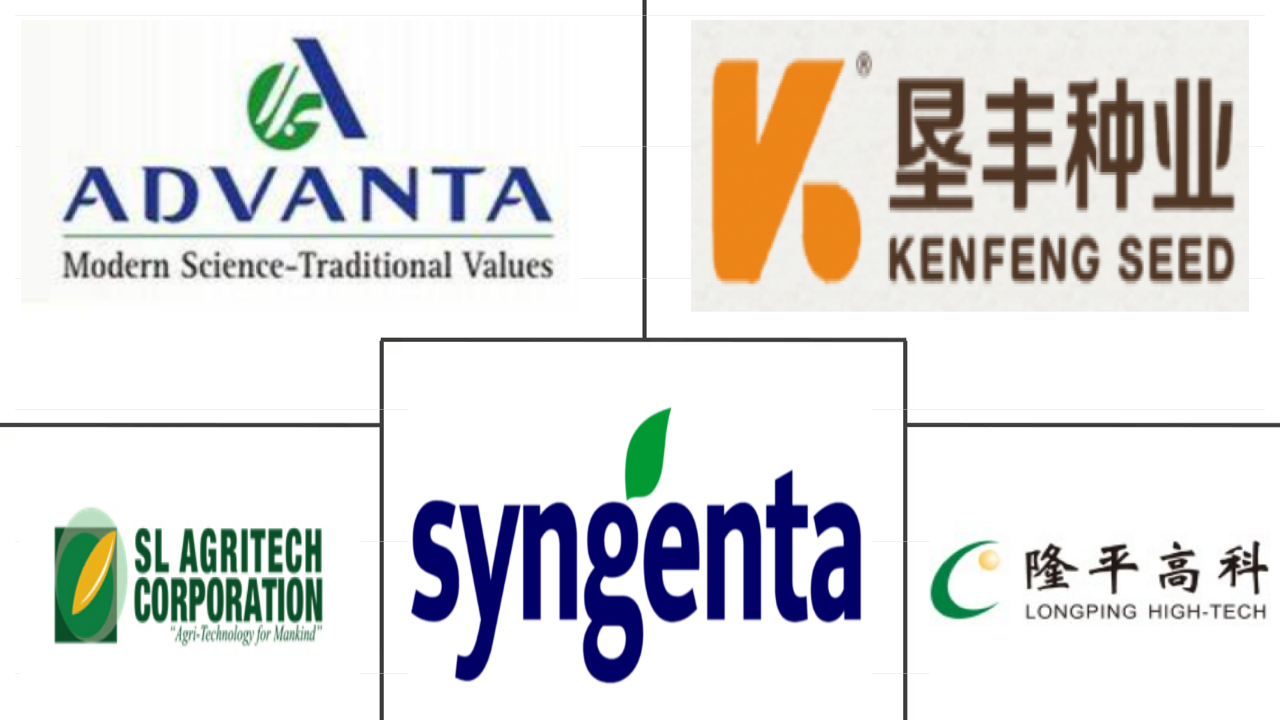Market Size of asia-pacific rice seed Industry
| Icons | Lable | Value |
|---|---|---|
|
|
Study Period | 2017 - 2030 |
|
|
Market Size (2024) | USD 4.32 Billion |
|
|
Market Size (2030) | USD 5.22 Billion |
|
|
Largest Share by Breeding Technology | Open Pollinated Varieties & Hybrid Derivatives |
|
|
CAGR (2024 - 2030) | 3.19 % |
|
|
Largest Share by Country | China |
|
|
Market Concentration | Low |
Major Players |
||

|
||
|
*Disclaimer: Major Players sorted in no particular order |
Asia-Pacific Rice Seed Market Analysis
The Asia-Pacific Rice Seed Market size is estimated at 4.32 billion USD in 2024, and is expected to reach 5.22 billion USD by 2030, growing at a CAGR of 3.19% during the forecast period (2024-2030).
4.32 Billion
Market Size in 2024 (USD)
5.22 Billion
Market Size in 2030 (USD)
3.24 %
CAGR (2017-2023)
3.19 %
CAGR (2024-2030)
Largest Market by Breeding Technology
58.76 %
value share, Open Pollinated Varieties & Hybrid Derivatives, 2023
Growers use these seeds as they are cost-effective, support organic cultivation, and are for fresh market utilization as the rice produced has a good taste and is chemical free.
Largest Market by Country
42.61 %
value share, China, 2023
The country extensively employs high-yielding rice varieties to meet local demand, and it is the only nation in the region approved for cultivating insect-resistant GM rice seeds.
Fastest-growing Market by Breeding Technology
3.40 %
Projected CAGR, Open Pollinated Varieties & Hybrid Derivatives, 2024-2030
It is projected to witness growth as the crop requires a large number of seeds to be sown for good cultivation, and small-scale growers save input costs for cultivation.
Fastest-growing Market by Country
9.37 %
Projected CAGR, Australia, 2024-2030
It is the fastest-growing country as the growers increased cereal cultivation for a high ROI. The government's support to boost domestic production and reduce imports fuels this growth.
Leading Market Player
4.10 %
market share, Syngenta Group, 2022

The company has made strategic partnerships and expansions in the region. It opened its new USD 100 million R&D facility in India to develop new seed varieties.
Hybrid rice seeds will be adopted more in the future due to benefits such as resistance to diseases and drought, as well as the increasing food demand
- In Asia-Pacific, the open-pollinated varieties and hybrid derivatives (OPV's) seed segment dominated the market by volume and value. In 2022, OPV rice seeds accounted for 58.7% of the region's rice seed market.
- The adoption of open-pollinated varieties is mainly due to their lower cost than hybrid seeds. The major restraining factor of hybrid rice is that the rice yield grain declines significantly after the first generation of seeds (F1). Therefore, farmers purchase new seeds every season to cultivate hybrid rice.
- In 2022, hybrid rice seeds had a market share of 41.3%. The hybrid rice market, in terms of value, is estimated to record a CAGR of 2.9% during the forecast period (2023-2030), mainly due to increasing food demand owing to the rising population in the region and high demand for drought tolerance and disease resistance traits. For instance, brands such as Bayer AG's Arize Tej Gold provide resistance to seeding blight, and Vina Seed's Thein Uu8 provides resistance to different diseases, such as blast and sheath blight, along with higher productivity. Additionally, hybrid rice seeds improve food security by 15-20% compared to OPV rice seeds. Another major factor likely to drive the growth of hybrid rice seeds is their ability to resist abiotic and biotic stresses.
- Due to the low adoption rate of hybrid rice and the lack of proper input assistance, the OPVs market has dominated the market more than hybrid seeds in many countries. Thus, to increase the incentive to adopt hybrid rice, a hybrid variety that produces superior grain quality and resistance to stresses must be developed and distributed at lower prices in major rice-producing countries of the region.
Asia-Pacific being largest producer and consumer of rice with increasing cultivation area and export demand, the region is expected to grow in the future
- Asia-Pacific is one of the largest producers of rice in the global market. China dominated the Asia-Pacific rice seed market, accounting for 41.5%, followed by the Philippines (12.6%), Thailand (10.1%), and Japan (8.9%) in 2022. Moreover, in China, rice is one of the major cereal crops, and about 65% of Chinese people rely on rice. Globally, China had a market share of 32.6% in the same period.
- The area under rice cultivation in China was 30.4 million hectares in 2022, which was a decrease of 1.9% from 2017 due to crop diversification and urbanization in the country. However, the usage of hybrids increased production in the country.
- There is a high demand for rice cultivated in Asia-Pacific, especially India, by Western and other countries. For instance, in 2020-21, India’s rice exports increased by 87% to 17.72 million metric ton in 2022 from 9.49 million metric ton in 2020. However, a ban on a variety of rice and a higher export duty of 20% has not affected the export quantity as of April-May 2023, which was 21.1% higher than the same period in 2022. Therefore, there is high demand for rice in domestic and international markets, which will help in the growth of rice seeds in the country during the forecast period.
- The transgenic rice grown commercially in the Philippines is Golden rice (GR), which accounted for 3.5% of the country’s hybrid rice seed market in 2022. Golden rice (GR) is a transgenic rice that is an effective source of Vitamin A. The transgenic rice segment is projected to register a CAGR of 5.3% in the Philippines during the forecast period as Golden Rice (GR) witnesses high demand.
- The high consumption and increased use of hybrid seeds for higher productivity are expected to help the growth of the rice seed market during the forecast period.
Asia-Pacific Rice Seed Industry Segmentation
Hybrids, Open Pollinated Varieties & Hybrid Derivatives are covered as segments by Breeding Technology. Australia, Bangladesh, China, India, Indonesia, Japan, Myanmar, Pakistan, Philippines, Thailand, Vietnam are covered as segments by Country.
- In Asia-Pacific, the open-pollinated varieties and hybrid derivatives (OPV's) seed segment dominated the market by volume and value. In 2022, OPV rice seeds accounted for 58.7% of the region's rice seed market.
- The adoption of open-pollinated varieties is mainly due to their lower cost than hybrid seeds. The major restraining factor of hybrid rice is that the rice yield grain declines significantly after the first generation of seeds (F1). Therefore, farmers purchase new seeds every season to cultivate hybrid rice.
- In 2022, hybrid rice seeds had a market share of 41.3%. The hybrid rice market, in terms of value, is estimated to record a CAGR of 2.9% during the forecast period (2023-2030), mainly due to increasing food demand owing to the rising population in the region and high demand for drought tolerance and disease resistance traits. For instance, brands such as Bayer AG's Arize Tej Gold provide resistance to seeding blight, and Vina Seed's Thein Uu8 provides resistance to different diseases, such as blast and sheath blight, along with higher productivity. Additionally, hybrid rice seeds improve food security by 15-20% compared to OPV rice seeds. Another major factor likely to drive the growth of hybrid rice seeds is their ability to resist abiotic and biotic stresses.
- Due to the low adoption rate of hybrid rice and the lack of proper input assistance, the OPVs market has dominated the market more than hybrid seeds in many countries. Thus, to increase the incentive to adopt hybrid rice, a hybrid variety that produces superior grain quality and resistance to stresses must be developed and distributed at lower prices in major rice-producing countries of the region.
| Breeding Technology | |||||||
| |||||||
| Open Pollinated Varieties & Hybrid Derivatives |
| Country | |
| Australia | |
| Bangladesh | |
| China | |
| India | |
| Indonesia | |
| Japan | |
| Myanmar | |
| Pakistan | |
| Philippines | |
| Thailand | |
| Vietnam | |
| Rest of Asia-Pacific |
Asia-Pacific Rice Seed Market Size Summary
The Asia-Pacific rice seed market is poised for steady growth, driven by the region's status as a major global rice producer and consumer. The market is characterized by a significant presence of open-pollinated varieties (OPVs) and hybrid seeds, with OPVs dominating due to their cost-effectiveness. However, hybrid seeds are gaining traction due to their superior traits, such as drought tolerance and disease resistance, which are increasingly important given the region's growing population and changing climatic conditions. The demand for rice seeds is further bolstered by the high consumption rates in countries like China and India, where rice is a staple food. The market is also witnessing advancements in seed technology, with companies focusing on developing hybrids that offer better grain quality and stress resistance.
China leads the Asia-Pacific rice seed market, followed by countries like the Philippines, Thailand, and Japan. The region's rice cultivation area has seen fluctuations due to urbanization and crop diversification, but the demand for rice remains robust, both domestically and internationally. This demand is reflected in the increased rice exports from countries like India, despite challenges such as export bans and duties. The market is fragmented, with key players like Advanta Seeds, Beidahuang Kenfeng Seed Co. Ltd, SL Agritech Corporation, Syngenta Group, and Yuan Longping High-Tech Agriculture Co. Ltd playing significant roles. Collaborative efforts and research initiatives are expected to drive further growth, as companies strive to meet the rising demand for high-quality, resilient rice seeds.
Asia-Pacific Rice Seed Market Size - Table of Contents
-
1. MARKET SEGMENTATION (includes market size in Value in USD, Forecasts up to 2030 and analysis of growth prospects)
-
1.1 Breeding Technology
-
1.1.1 Hybrids
-
1.1.1.1 Non-Transgenic Hybrids
-
1.1.1.2 Transgenic Hybrids
-
1.1.1.2.1 Insect Resistant Hybrids
-
1.1.1.2.2 Other Traits
-
-
-
1.1.2 Open Pollinated Varieties & Hybrid Derivatives
-
-
1.2 Country
-
1.2.1 Australia
-
1.2.2 Bangladesh
-
1.2.3 China
-
1.2.4 India
-
1.2.5 Indonesia
-
1.2.6 Japan
-
1.2.7 Myanmar
-
1.2.8 Pakistan
-
1.2.9 Philippines
-
1.2.10 Thailand
-
1.2.11 Vietnam
-
1.2.12 Rest of Asia-Pacific
-
-
Asia-Pacific Rice Seed Market Size FAQs
How big is the Asia-Pacific Rice Seed Market?
The Asia-Pacific Rice Seed Market size is expected to reach USD 4.32 billion in 2024 and grow at a CAGR of 3.19% to reach USD 5.22 billion by 2030.
What is the current Asia-Pacific Rice Seed Market size?
In 2024, the Asia-Pacific Rice Seed Market size is expected to reach USD 4.32 billion.

